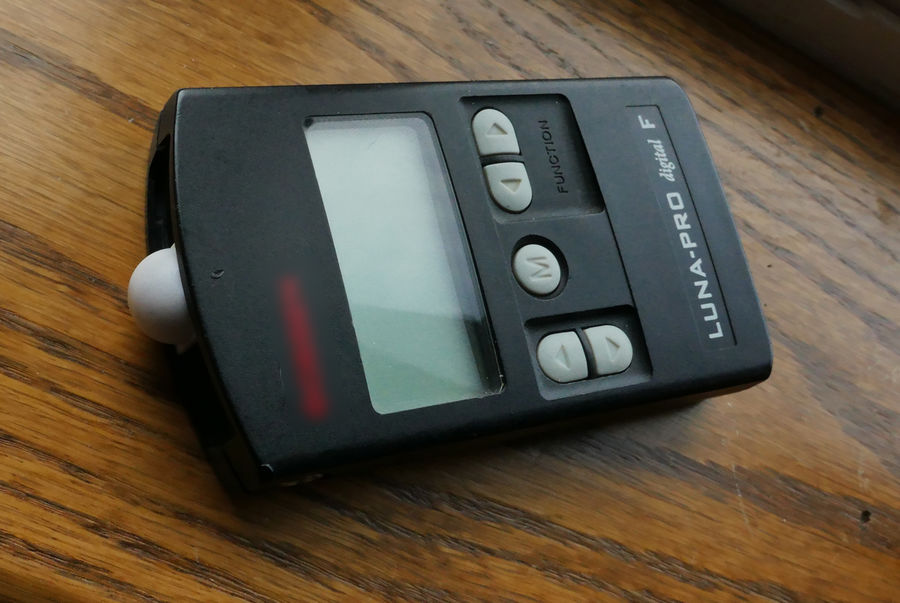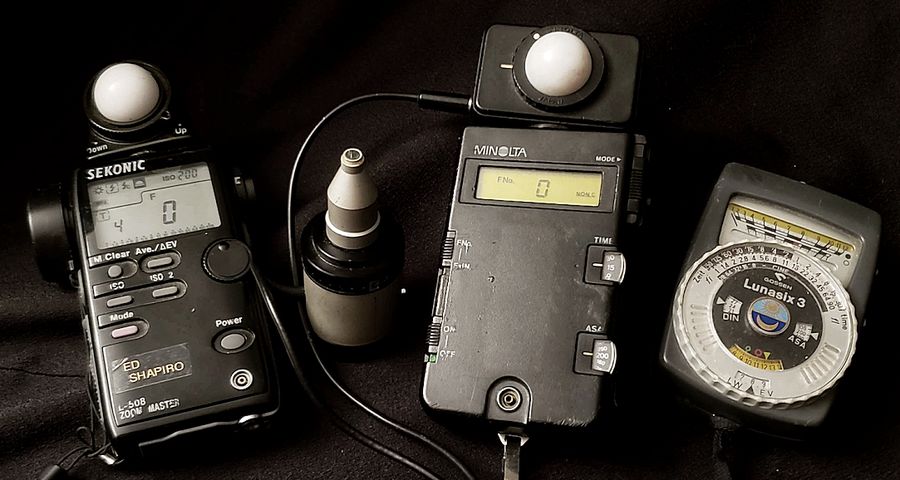Hand held incident
Oct 16, 2021 12:55:54 #
If I can get an answer that I can use, I'm not afraid to ask a dumb question. Duck!...here come's one now!
I am used to in camera metering on a variety of cameras I've owned, but am interested in trying out incident rather than reflected meter readings. I understand the concept and the advantages of incident readings, but this particular meter I have raises a simple question. It is one of the few that I've seen that has the domed meter on top pointed up and not facing front. I have to assume that in order to get an accurate incident meter readings outdoors I have to tip the meter "down", and pointed towards the camera so to speak. Holding the meter under the subject's chin where you would actually be able to see the readout would cause an underexposure since the dome is reading more sky. Am I not understanding how an incident meter works?
I am used to in camera metering on a variety of cameras I've owned, but am interested in trying out incident rather than reflected meter readings. I understand the concept and the advantages of incident readings, but this particular meter I have raises a simple question. It is one of the few that I've seen that has the domed meter on top pointed up and not facing front. I have to assume that in order to get an accurate incident meter readings outdoors I have to tip the meter "down", and pointed towards the camera so to speak. Holding the meter under the subject's chin where you would actually be able to see the readout would cause an underexposure since the dome is reading more sky. Am I not understanding how an incident meter works?

Oct 16, 2021 13:04:46 #
Been a while, but Incident meters the light falling on the subject, not reflected from. Hold with the dome facing up.
Oct 16, 2021 13:15:28 #
This might be of some help - https://www.butkus.org/chinon/flashes_meters/gossen_luna-pro_digital_f/gossen_luna-pro_digital_f.htm
Oct 16, 2021 13:19:38 #
quixdraw wrote:
Been a while, but Incident meters the light falling on the subject, not reflected from. Hold with the dome facing up.
Making sure of course that the light hitting dome is the same as the light hitting the subject. If you are in shade and the subject is not, all bets are off. Go back to the reflected meter.
---
Oct 16, 2021 13:27:27 #
Bill_de wrote:
Making sure of course that the light hitting dome is the same as the light hitting the subject. If you are in shade and the subject is not, all bets are off. GO BACK TO THE REFLECTED METER.
---
---
.....or go and stand where the subject is and get your readings (and your settings) from there. Whether you're standing in shade or not doesn't matter - it's what the camera sees that matters.
Oct 16, 2021 13:28:22 #
You do have to point the dome at the camera from the subject position and it does make it difficult to see the display while doing so but I think the display would hold the reading after you release the button.
Oct 16, 2021 13:53:02 #
BebuLamar wrote:
You do have to point the dome at the camera from the subject position and it does make it difficult to see the display while doing so but I think the display would hold the reading after you release the button.
Altho you’re 111% correct, simple solutions are really unpopular around here.
Another way to understand positioning the dome is that the dome is the subject’s “body double”. Make it model the subject a best you can.
~~~~~~~~~~~~~~~~~~~~~~~
Dome facing the sky? Great for a subject thaz lying on the ground while you shoot downward (carefully not casting your own shadow within the frame). IOW the dome ALWAYS faces the lens.
Outside of the studio, using a dome instead of the camera meter is like push starting a Tesla. Looks very “Olde Skoole” but is nothing more than theatrics. You don’t even need a working meter for that. Buy a broken one ... it’s way cheaper. Also helps to wear an ascot and a beret, and mumble to yourself.
Oct 16, 2021 13:57:01 #
Your meter's design is very compact and does not feature the swivel-head to house the dome. Nonetheless, the meter is used the same way as the more elaborate meters, that is held at the subject and aimed at the camera. It's just a matter of getting used to holding the meter in such a way that you don't block the light that strikes the dome from the direction of the camera while the reading is being made.
The dome is a light collector that is "omnidirectional" so to speak. The readings will include light from directly above. This should not cause a false reading, however, there is an interesting caveat. Some of the more elaborate meters have a mechanism that recesses the dome , thereby shading it from the top and side lighting. Others have a removable dome that is interchangeable with a flat light receptor. These features are handy for making isolated readings in specific areas, for example, if you are shooting negative film and wish to expose the shadows and print down for the highlights or exposing for to the right or left for digital manipulation in post-processing. It is also useful in setting up lighting ratios between studio lights so as to get individual readings for each light source.
My advice- Shoot some test shots using your meter to calculate the exposure. First use at prescribed method- hold it at the subject and aim the dome of the camera. Chimp- check out the results and look at the histogram. If you somehow find that excessive skylight has caused underexposure, simply shade the top of the dome with your hand and see if there is an improvement.
My latest meter (6-years old) has a recess-able dome. I use that feature as stated above for specific readings of various parts of a scene or subject or to set up light ratios. My older Minolta meters is an antique- one of the first flash meter editions. When I shade the dome with my hand, I get the same results as the more sophisticated meter.
Your meter is most likely accurate. It's a matter of gettg used to it, putting it through its paces, and learning how to interpret the readings.
Theoretically, your incident light meters should jibe with a refected light reading made with an 18% gray card. You still have to know how to make the readings, where to probe, and how to sometimes second-guess your meter and make a few various readings. Your meter should, at least, get you well into the ballpark pending your own precise tweaking.
The dome is a light collector that is "omnidirectional" so to speak. The readings will include light from directly above. This should not cause a false reading, however, there is an interesting caveat. Some of the more elaborate meters have a mechanism that recesses the dome , thereby shading it from the top and side lighting. Others have a removable dome that is interchangeable with a flat light receptor. These features are handy for making isolated readings in specific areas, for example, if you are shooting negative film and wish to expose the shadows and print down for the highlights or exposing for to the right or left for digital manipulation in post-processing. It is also useful in setting up lighting ratios between studio lights so as to get individual readings for each light source.
My advice- Shoot some test shots using your meter to calculate the exposure. First use at prescribed method- hold it at the subject and aim the dome of the camera. Chimp- check out the results and look at the histogram. If you somehow find that excessive skylight has caused underexposure, simply shade the top of the dome with your hand and see if there is an improvement.
My latest meter (6-years old) has a recess-able dome. I use that feature as stated above for specific readings of various parts of a scene or subject or to set up light ratios. My older Minolta meters is an antique- one of the first flash meter editions. When I shade the dome with my hand, I get the same results as the more sophisticated meter.
Your meter is most likely accurate. It's a matter of gettg used to it, putting it through its paces, and learning how to interpret the readings.
Theoretically, your incident light meters should jibe with a refected light reading made with an 18% gray card. You still have to know how to make the readings, where to probe, and how to sometimes second-guess your meter and make a few various readings. Your meter should, at least, get you well into the ballpark pending your own precise tweaking.

Oct 16, 2021 22:18:00 #
quixdraw wrote:
Been a while, but Incident meters the light falling on the subject, not reflected from. Hold with the dome facing up.
Thanks for replying quixdraw. I understand that using it as an incident meter reads the light falling on the subject. But my question is with all the other meters I see that have the dome, they are basically pointing back to the camera if held say under the persons chin. It would read the sky, the grass, and whats on either side. This meter is pointing to the sky and if held that way it doesnt seem like it would read as much as if it were pointing back to the camera.
Oct 16, 2021 22:21:05 #
krl48 wrote:
This might be of some help - https://www.butkus.org/chinon/flashes_meters/gossen_luna-pro_digital_f/gossen_luna-pro_digital_f.htm
You nailed it krl48. It says in the manual with the dome in place it should be pointing back to the camera. Wish I could've found that manual from 10 yrs ago.
Oct 17, 2021 00:07:24 #
AndyT wrote:
You nailed it krl48. It says in the manual with the dome in place it should be pointing back to the camera. Wish I could've found that manual from 10 yrs ago.
Here is a link to your manual:
https://www.cameramanuals.org/flashes_meters/gossen_luna-pro_digital.pdf
Oct 17, 2021 09:15:42 #
I would swear, that in all my experience, I recall the idea of pointing the incident receptor towards the main light source ! ? - which is what I did. This idea seems to fulfill the whole concept of "incidence" ........
.
.
Oct 17, 2021 09:27:56 #
The reason for putting the dome in such a position because:
1. It's an dual mode Reflected and Incident meter and using 1 photo cell. For an incident only meter they would put it on the front of the meter.
2. In the case of the Minolta in EL. post the measuring head can be turned for Incident or Reflective.
3. In the case of the Sekonic it seems to have 2 photocells or optic so that you can aim it differently for spot or incident.
4. The Luna Six is similar in design to your meter and thus you would have to do it the same way. If they put the dome in front of the meter then when reading reflective you're looking at the back of the meter rather than the display.
1. It's an dual mode Reflected and Incident meter and using 1 photo cell. For an incident only meter they would put it on the front of the meter.
2. In the case of the Minolta in EL. post the measuring head can be turned for Incident or Reflective.
3. In the case of the Sekonic it seems to have 2 photocells or optic so that you can aim it differently for spot or incident.
4. The Luna Six is similar in design to your meter and thus you would have to do it the same way. If they put the dome in front of the meter then when reading reflective you're looking at the back of the meter rather than the display.
Oct 17, 2021 09:36:27 #
dbrugger25
Loc: Raleigh, NC
There are several light meter apps for smartphones. Has anyone tested them? Are they accurate and useful? Tjey certainly a whole lot less expensive than a quality light meter,
Oct 17, 2021 09:44:06 #
AndyT wrote:
If I can get an answer that I can use, I'm not afr... (show quote)
Dome should be up, towards the main light falling on the subject. If the subject is getting sky light, the meter needs to read it.
That being said, incident meters are extremely effective in studio settings, or when you have control over the light, and in situations were you can place and read the meter in the same light as what is illuminating the subject.
They are close to useless shooting wildlife in a blind, a cityscape at night, a night sports event, a stage performance, a moon or night sky shot, etc etc etc. I have relied on reflected meter readings since 2006, but still own two hand-held analog Gossen combo incident/reflected meters that I "occasionally" use - a Lunapro and a Lunapro SBC, which has a flash attachment that works great for setting lighting ratios.
If you want to reply, then register here. Registration is free and your account is created instantly, so you can post right away.








